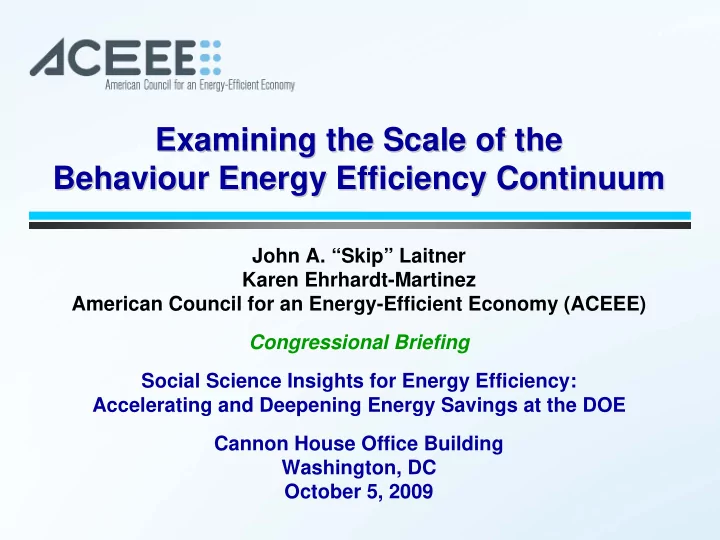

Examining the Scale of the Examining the Scale of the Behaviour Energy Efficiency Continuum Energy Efficiency Continuum Behaviour John A. “Skip” Laitner Karen Ehrhardt-Martinez American Council for an Energy-Efficient Economy (ACEEE) Congressional Briefing Social Science Insights for Energy Efficiency: Accelerating and Deepening Energy Savings at the DOE Cannon House Office Building Washington, DC October 5, 2009
An Opening Commentary An Opening Commentary • Energy efficiency many be the farthest reaching, least- polluting, and fastest growing energy success story of the last 40 years. But it is a highly invisible success story, and certainly not one that is typically reflected in policy models. . . • We’ve accomplished a lot, but a deeper examination suggests that it’s only the tip of the potential improvement opportunity. • Stepping outside the usual economic-modeling framework of “getting the technologies and the prices right,” needed are policies and program innovations that create systematic improvements driven by informed and motivated behaviors. • And to begin promoting that path, we pose the question: “How big can behavior actually become in achieving greater energy efficiencies?”
“Images of the future are critical to choice-oriented behavior” Kenneth Boulding
There is no economic or physical law. . . There is no economic or physical law. . . Imagine a U.S. economy in 2030 that is 70% larger than today The “official future” Add more productive technology With a little behavioral change And with a little imagination. . . Perhaps the biggest constraint is imagination, the political will, and the economic models which limit this vision or opportunity. . .
Estimating the Household Behavioral Estimating the Household Behavioral Energy Efficiency Resource Energy Efficiency Resource • Residential energy use and household use of personal vehicles amounts to about 38% of total U.S. energy consumption today. • The question is, how much of an energy efficiency gain might be supported through energy-smart behaviors? • To answer this question we explored an estimated 100 separate conservation and energy efficiency measures (all cost-effective) that could be taken in a short period of time. • Using a Monte Carlo probability simulation – allowing a random distribution of participation, effectiveness, and saving magnitudes – we found an energy savings potential on the order of about 9 Quads compared to current use. Source: Laitner, Ehrhardt-Martinez, and McKinney 2009
Major Residential Energy End Uses in the United States for 2008 End Use Category Energy Consumed (Quads) Percent of Total Space Heating 6.2 16.1% Air Conditioning 2.4 6.1% Lighting 6.0% 2.3 Hot Water 6.3% 2.5 Refrigeration 3.8% 1.4 Consumer Appliances 8.6% 3.3 Other Uses Not Specified 10.4% 4.0 Personal Transportation 16.5 42.8% Total End Use Energy 38.5 100.0% Source: Energy Information Administration (2008)
Categories of Household Behaviours Behaviours Categories of Household that Impact Residential Energy Use that Impact Residential Energy Use Frequency of Action Infrequent Frequent Install compact fluorescents Slower Highway driving Pull fridge away from wall Slower Acceleration Consumer Cost Low-cost / no cost Inflate tires adequately Air Dry Laundry Install Weather Stripping Turn Off Computers, Other Devices New energy-efficient windows New energy-efficient appliances Higher cost / Investment Additional Insulation New energy-efficient car New energy-efficient AC/furnace
Range of Savings and Participation * * Rates by End Use Category Range of Range of Policy-driven Expected Major End Uses Potential Savings Participation Savings Space Heating 18-36% 3-40% 27% Air Conditioning 19-47% 2-75% 33% Lighting 10-53% 20-80% 32% Hot Water 6-26% 3-75% 16% Refrigeration 17-55% 5-75% 36% Consumer Appliances 6-20% 40-80% 13% Other Uses Not Specified 12-24% 30-50% 18% Personal Transportation 14-33% 30-80% 24% Total End Use Impacts 18-28% n/a 23% * Presented with the simple caveat that these are first investigative efforts designed only to explore * new perspectives and a new accounting framework rather than to offer precise estimates at this time.
Potential Near-Term Household and Personal Transportation Energy Savings Potential National Energy Category of Actions Savings (Quads) Conservation, Lifestyle, Awareness, Low- 4.9 (57% of total savings) Cost Actions Investment Decisions 3.7 (43% of total savings) Total Energy Savings ~8.6 +/- 1.5 (22% of HH energy) Source: Laitner, Ehrhardt-Martinez, and McKinney 2009
How Much is 9 Quads of Efficiency? • ~9% of total U.S. energy consumption in 2008 delivered over a period of 5-8 years; • ~600 gallons of gasoline equivalent per household; • ~240 medium coal-fired power plants; and • Roughly equal to total annual energy consumption of either Brazil or South Korea, and just slightly less than total annual energy consumption in the UK (~10 Quads), France (~11 Quads) and Germany (~14 Quads) Conclusion? Should we take the time to understand the behavioral perspective and recognize its full “resource potential,” it can be a very big deal – but only if we choose to develop it. . . .
Some Further Research Areas. . . . Some Further Research Areas. . . . • Beyond the household, cost-effective, economy-wide efficiency gains might be on the order of 30 percent by 2030 – potentially rising to 60 percent savings or more by 2050. • Expand the range of inquiry so that we better understand people as more than economically rational actors. • Translate these findings and related research into a broader range of policy tools to promote long-term, sustainable efficiency. • The analysis here examines only the direct energy savings by the consumer. Omitted are: – Producer innovations which might amplify consumer savings – Social decisions affecting household size, urban densities, recycling and dematerialization, flexible work schedules and locations (teleworking, telecommuting, and videoconferencing)
The difficulty lies not with the new ideas, but in escaping the old ones. . . . John Maynard Keynes
Contact Information Contact Information John A. “Skip” Laitner Director, Economic and Social Analysis jslaitner@aceee.org Karen Ehrhardt-Martinez, Chair Behavior, Energy, Climate Change (BECC) Conference kehrhardt@aceee.org American Council for an Energy-Efficient Economy (ACEEE) National Press Building 529 14 th Street NW, Suite 600 Washington, DC 20045 o: (202) 509-4000 For more information and updates visit: www.aceee.org and www.BECCconference.org
Recommend
More recommend